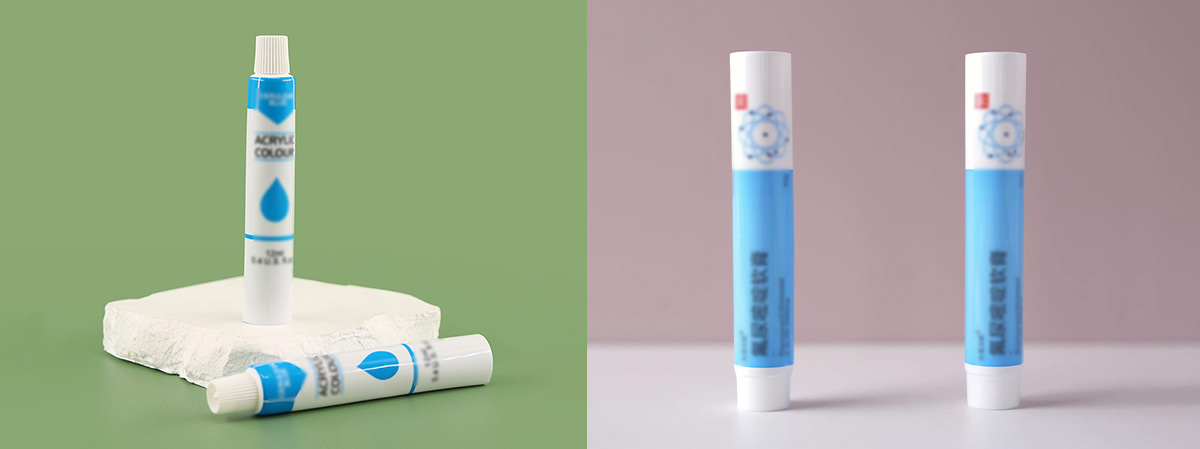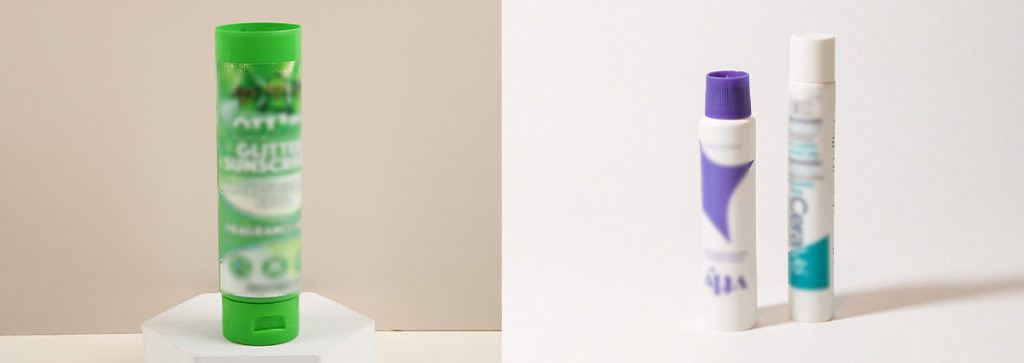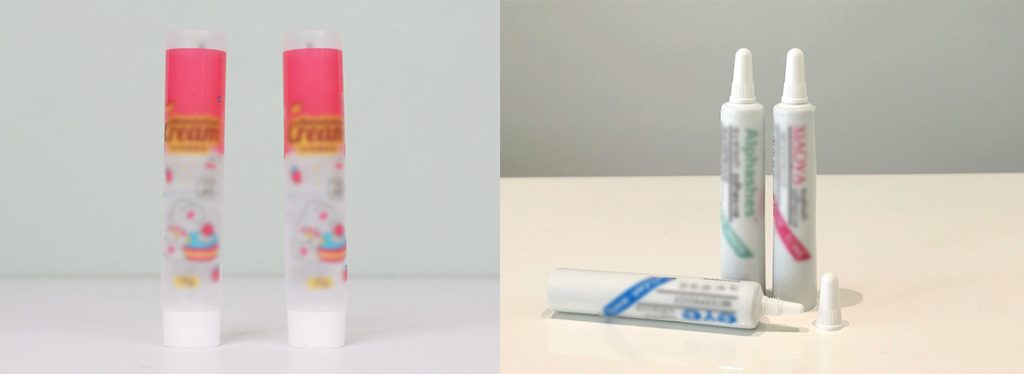

Sample testing services play a crucial role in lami tube manufacturing by ensuring material quality and product integrity. Pressure testing and crush testing help identify weak tube seals, which can lead to leakage. Tube seal testing also detects contamination risks, such as biofilm formation and pathogenic bacteria growth. Laboratory testing and stability testing certify tubes for compliance and durability. High quality tube seals prevent product failure and protect consumers from health issues. Companies rely on testing services to maintain reliable tube performance.
| Testing Method | Description | Impact on Leakage and Contamination |
|---|---|---|
| Pressure Testing | Pumps compressed air into a sealed tube to check for leaks. | Ensures seals are of appropriate quality to prevent leakage. |
| Crush Testing | Simulates real-world conditions by crushing tubes to test seal integrity. | High-quality seals should withstand pressure without leaking. |
- Pathogenic bacteria can grow in polymeric tubes.
- Biofilm formation increases health risks.
- Careful material selection lowers contamination chances.
Key Takeaways
- Sample testing services are essential for ensuring the quality and safety of lami tubes. They help detect defects and prevent leaks.
- Pressure testing and crush testing are key methods that identify weak seals and ensure tubes can withstand real-world conditions.
- Regular testing helps manufacturers maintain high standards and comply with safety regulations, protecting consumers from health risks.
- Using testing data allows manufacturers to optimize materials, reduce waste, and lower production costs while improving product quality.
- Fire testing is crucial for selecting safe materials, ensuring that lami tubes meet fire safety standards and protect products.
Material Quality in Lami Tube Manufacturing
Risks: Leakage and Contamination
Leakage and product contamination present major risks in lami tube manufacturing. When a tube seal fails, contents can escape, leading to wasted product and potential health hazards. Pathogenic bacteria and biofilm formation inside tubes increase the risk of contamination. Manufacturers use lami tube making machine to produce tubes with precise seals, reducing these risks. Careful selection of materials helps prevent product contamination by creating strong barriers against moisture, air, and bacteria. Laminated tube designs offer enhanced protection, extending shelf life and maintaining product safety.
- The barrier properties of laminated tubes contribute to longer shelf life for pharmaceutical and cosmetic products.
- These tubes block moisture, air, and UV light, protecting contents from external contamination.
- Technological improvements in packaging materials continue to enhance barrier performance.
Durability and Stability
Durability and stability determine how well a tube withstands daily use and environmental stress. Manufacturers evaluate mechanical strength, electrical insulation, and thermal stability to ensure tubes remain reliable. The table below highlights critical properties for tube durability:
| Property | Description |
|---|---|
| Mechanical Strength | Exceptional tensile strength to withstand high loads and mechanical stress. |
| Electrical Insulation | High dielectric strength, suitable for high-voltage applications without electrical breakdown. |
| Thermal Stability | Maintains properties across a broad temperature range, ensuring dimensional stability. |
Lami tube manufacturing relies on materials that resist deformation and maintain integrity under pressure. The interaction of metal layers in laminated tubes affects wrinkle resistance, which is vital for tube appearance and function.
Role of Materials in Tube Performance
Materials play a central role in tube performance. Most manufacturers use PE (polyethylene), which holds 90% of the market share, and EVOH (ethylene vinyl alcohol) for improved barrier properties. The multilayer structure of a laminated tube provides flexibility, barrier protection, and cost efficiency. The table below compares common materials and their performance characteristics:
| Material Type | Performance Characteristics |
|---|---|
| Laminated Tubes | Excellent barrier protection against oxygen, moisture, and light; more flexible than pure aluminum; allows full-color printing; cheaper than pure metal tubes. |
| PE (Polyethylene) | Accounts for 90% of the market share; relatively single material used in plastic cosmetic tubes. |
| EVOH (Ethylene Vinyl Alcohol) | Used in combination with PE for enhanced barrier properties. |
- Laminated tubes offer extended shelf life and enhanced product protection.
- The elastic modulus, Poisson ratio, strength coefficient, and hardening index influence wrinkle resistance and overall tube quality and strength.
- Yield strength and ultimate tensile strength increase with thinning rate, improving tube performance through work hardening and grain refinement.
Testing Methods for Lami Tube Manufacturing
Pressure Testing
Pressure testing stands as a fundamental procedure in lami tube manufacturing. Technicians use a controlled testing environment to pump compressed air or liquid into the tube, checking for leaks and weaknesses in the tube seal. The astm e136 test provides a standardized approach for evaluating the fire resistance and pressure integrity of materials. Operators follow strict procedures to ensure accuracy. The table below outlines standard procedures:
| Procedure Type | Description |
|---|---|
| General | Valves must be tested with the injection system empty and free from trapped air during liquid tests. |
| Backseat Test | Required for valves with backseat features, applying pressure inside the valve with ends closed. |
| Shell Test | Pressure applied inside the valve with ends closed and valve partially open to test the stuffing box. |
Pressure testing identifies weak points in the tube, preventing leakage and product loss. Quality control studies show several failure modes during pressure testing:
| Type of Failure | Description |
|---|---|
| Catastrophic Failure | All tubes exhibited catastrophic failure approximately central to their length. |
| Inelastic Buckling | Failure initiated at the center of the tube due to inelastic buckling and axisymmetric yield failure. |
| Brittle Failure | Satin weave tubes exhibited a more brittle failure compared to plain weave due to fiber orientation. |
| Hoop Stress Dominated Failure | Low angle braided composite tubes showed cracks running along the length due to hoop stress. |
| Axial Load Dominated Failure | Composite tubes with fibers oriented towards the hoop direction had axial load dominated failure mode. |
Pressure testing ensures that the lami tube making machine produces tubes with reliable seals. The astm e136 test helps verify that the materials used in laminated tube construction meet safety and performance standards. Pressure must be applied evenly to avoid false results. Tube seal testing also relies on pressure testing to confirm the integrity of the seal.
Crush Testing
Crush testing evaluates the ability of a tube to withstand external forces. Technicians apply pressure to the tube until it deforms or fails. The astm e136 test is used to assess the fire resistance and mechanical strength of materials under crushing conditions. High-quality lami tube manufacturing requires tubes to resist permanent deformation during low-speed impacts. The following values represent typical crush resistance for laminated tube materials:
| SEA Range (kJ/kg) |
|---|
| 27 – 40 |
- Pip is essential for evaluating the crushing response of structures, especially under low-speed impacts, where permanent deformation is undesirable.
Specific Absorbed Energy (SEA) measures the energy absorbed per unit mass during impact. This metric is crucial for assessing the performance of composite tubes under crushing conditions. Crush testing helps manufacturers select materials that maintain tube shape and function during transport and use. The astm e136 test provides guidelines for evaluating crush resistance in a controlled testing environment.
Stability Testing

Stability testing examines how a tube and its contents respond to environmental stress over time. Technicians expose tubes to varying temperatures, humidity, and light, then monitor changes in appearance, strength, and barrier properties. The astm e136 test offers a framework for assessing the fire resistance and long-term stability of materials. Stability testing ensures that laminated tube products retain their protective qualities throughout their shelf life. Manufacturers use stability testing to verify that the lami tube making machine produces tubes that meet industry standards for durability. The astm e136 test helps confirm that materials do not degrade or lose effectiveness under normal storage and use conditions.
Laboratory Testing
Laboratory testing detects material defects and verifies tube quality. Technicians use advanced methods to inspect tubes for internal and surface flaws. The astm e136 test serves as a reference for evaluating fire resistance and material integrity. The table below summarizes effective laboratory testing methods:
| Testing Method | Description | Advantages |
|---|---|---|
| Ultrasonic Testing (UT) | Uses high-frequency sound waves to detect internal and subsurface flaws. | Effective for identifying laminations and other critical defects that affect structural integrity. |
| Eddy Current Testing (ECT) | Detects surface and near-surface defects using electromagnetic induction. | Good for identifying surface cracks and conductivity issues. |
| Visual Testing (VT) | Involves direct visual inspection of the material. | Quick and cost-effective for identifying obvious surface defects. |
| Magnetic Particle Testing (MPT) | Uses magnetic fields to detect surface and near-surface defects. | Effective for ferromagnetic materials, especially for detecting cracks. |
| Radiographic Testing (RT) | Uses X-rays or gamma rays to view internal structures. | Good for detecting internal flaws and providing a visual representation of the material’s integrity. |
Laboratory testing helps manufacturers identify defects before tubes reach consumers. The astm e136 test ensures that materials meet fire safety and performance requirements. Technicians use these methods to confirm that the lami tube making machine produces tubes with consistent quality. Laminated tube products benefit from thorough laboratory testing, which reduces the risk of failure and improves reliability.
Tip: Regular testing using astm standards helps manufacturers maintain high-quality production and comply with industry regulations.
Combustibility of Materials and Fire Testing
Combustibility of Materials
Manufacturers must consider the combustibility of materials when producing lami tubes. Many organic matrix composites show inherent combustibility, which increases fire risk. Some composite systems, however, maintain structural integrity during fire exposure. Understanding the thermal response of these materials helps improve fire safety. The table below outlines the main fire risks associated with materials used in lami tube manufacturing process:
| Fire Risk Type | Description |
|---|---|
| Inherent combustibility | Organic matrix composites are inherently combustible, posing a significant fire risk. |
| Structural integrity under fire | Some composite systems maintain structural integrity in fire situations. |
| Testing methods | Standard tests like ignitability and cone calorimetry are used to assess fire risks. |
| Performance-led design | Performance-led design allows for better qualification of composites in fire risks. |
| Thermal response | Understanding thermal properties is crucial for mitigating fire risks in composite materials. |
Manufacturers use performance-led design to select materials that meet fire safety requirements. They also rely on standard testing methods to evaluate the combustibility of materials. Selecting non-combustible materials improves safety and reduces the risk of fire-related incidents. Fire safety decisions depend on a clear understanding of the fire performance of each material.
Fire Testing
Fire testing plays a vital role in ensuring the safety of lami tube products. Industry standards, such as the ASTM E136 test, assess the combustibility of materials. To classify as non-combustible, a material must not lose more than 50% of its weight during testing, and the temperature increase must stay below 30 degrees Celsius above the furnace temperature. No flaming should occur in the first 30 seconds. If weight loss exceeds 50%, the material must not exceed the furnace temperature and must not flame at any point.
Manufacturers use several fire testing standards to evaluate materials:
| Test Name | Description |
|---|---|
| 94HB | Horizontal Burn method |
| 94V | Vertical Burn test, more stringent than 94HB |
| 94VTM | Vertical Burn test for thin materials |
| 94-5V | For enclosures of non-movable products |
| 94HBF | For nonstructural foam materials |
| 94HF | For nonstructural foam materials |
| Radiant Panel | ASTM (E162) test for flame spread evaluation |
Manufacturers use these tests to ensure fire safety and compliance. Fire testing data helps them select materials that offer the best protection. Regular fire testing supports ongoing safety improvements and helps prevent fire hazards in packaging. Fire safety remains a top priority in lami tube manufacturing.
Using Testing Data for Material Selection
Improving Quality Control
Manufacturers in lami tube manufacturing rely on precise testing data to enhance quality control. They use specialized equipment to evaluate the performance of each tube and its seal. The following table shows common testing equipment and its purpose:
| Testing Equipment | Purpose |
|---|---|
| Peel/Seal/Bond Adhesion Strength Tester | Evaluates seal adhesion between film layers or labels. |
| Dart Impact Tester | Tests impact resistance against free-falling darts. |
| Laboratory Heat Sealer | Analyzes seal integrity under heat. |
| Coefficient of Friction (COF) Tester | Assesses static and kinetic friction of plastic films. |
| Rub Resistance Tester | Measures durability against repeated rubbing. |
| Scuff Resistance Tester | Examines scuffing endurance. |
| Vacuum Leak Tester | Detects leaks and micro-holes in packaging. |
| Digital Thickness Gauge | Measures material wall thickness. |
| Hot Air Oven (Lab) | Checks resistance against dry heat exposure. |
| Melt Flow Index Tester | Evaluates flow properties of materials. |
Testing data from these tools helps manufacturers identify weak seals, thin spots, or other defects in each tube. They can then adjust the lami tube making machine settings to improve consistency. Manufacturers also consider several important data points when selecting materials for laminated tube production:
- Barrier properties protect product integrity.
- Cost remains a key factor due to changing prices of plastics and aluminum.
- Sustainability influences material choices.
- Plastic laminated tubes offer flexibility, lightweight design, and cost-effectiveness.
- Aluminum tubes provide superior barrier protection.
Note: Consistent testing ensures every tube meets strict quality standards before reaching consumers.
Material Savings and Process Optimization
Testing data supports material savings and process optimization in laminated tube manufacturing. When manufacturers use advanced forming methods, they minimize defects such as wrinkling, which often leads to wasted materials. By forming composite laminates directly on the tool surface and applying pressure on both sides, they prevent wrinkle formation. This approach reduces waste and improves the efficiency of the lami tube making machine.
Testing also allows manufacturers to fine-tune the thickness and composition of each tube. They can use just enough material to maintain a strong seal and barrier, without excess. This optimization lowers costs and supports sustainability goals. Reliable testing data helps companies produce high-quality laminated tube products while reducing resource consumption and improving overall process efficiency.

Conclusion
Sample testing services help manufacturers improve material quality and reliability in lami tube production. These testing services support compliance, protect product integrity, and reduce material waste. Companies that use testing services see better results and fewer product failures. They can optimize processes and maintain high standards. For those seeking to enhance their manufacturing workflow, reaching out for more information about testing services can make a significant difference.
FAQ
What Is the Purpose of Sample Testing in Lami Tube Manufacturing?
Sample testing helps manufacturers detect defects, measure tube strength, and verify barrier properties. Technicians use these tests to ensure tubes meet safety standards and protect products from leakage and contamination.
How Often Should Manufacturers Perform Tube Testing?
Manufacturers should test every production batch. Regular testing helps maintain consistent quality and prevents defective tubes from reaching consumers. Frequent checks also support compliance with industry regulations.
Which Testing Method Detects Tube Leaks Most Effectively?
Pressure testing identifies leaks by applying air or liquid inside the tube. Technicians observe for drops in pressure or visible leaks. This method provides reliable results for seal integrity.
Can Testing Data Help Reduce Material Costs?
Testing data allows manufacturers to optimize tube thickness and composition. By using only the necessary amount of material, companies lower costs and reduce waste. Efficient testing supports sustainable production.
Why Is Fire Testing Important for Lami Tubes?
Fire testing evaluates the combustibility of tube materials. Manufacturers use these results to select safer materials and comply with fire safety standards. Fire-resistant tubes protect products and consumers from hazards.
